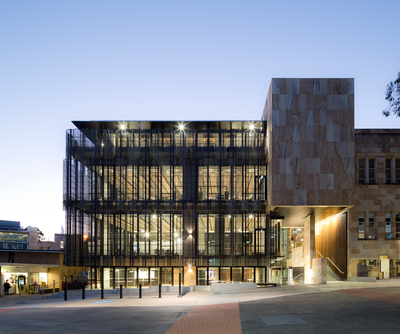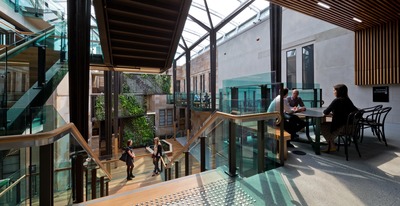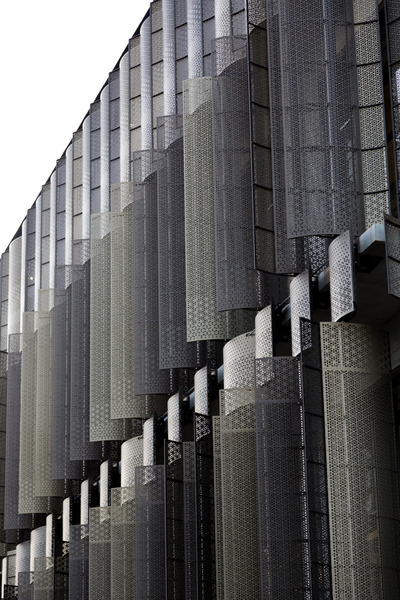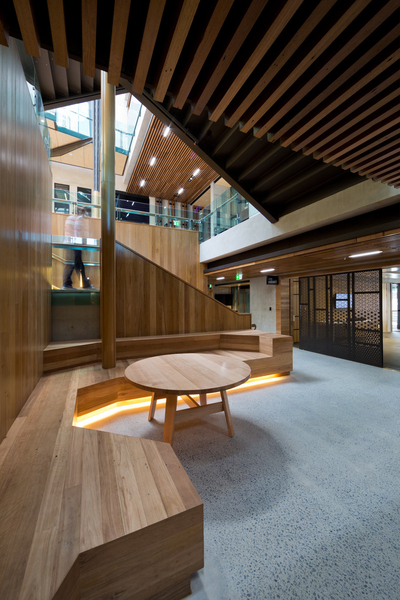Green building addresses global change
Friday, 22 November, 2013
The University of Queensland’s Global Change Institute (GCI), officially opened in August, was constructed to be a hub for research into sustainable building solutions. The building’s purpose is reflected in its design, with environmentally friendly features meaning the institute is carbon neutral and consumes zero net energy.
Operations Manager David Harris explained that almost half of the $32 million building’s funds were donated by philanthropist and sustainability enthusiast Graeme Wood. “After discussions with Graeme and the university executive,” Harris said, “we decided to try to provide an exemplar of sustainable design, construction and operation.”

International design practice Hassell was commissioned to design the building, with Hassell Principal Mark Roehrs saying the brief was for “a cutting-edge building that really pushed to next-generation design in sustainability … an exemplar sustainability office for the campus and to represent their commitment to issues around sustainability as a research organisation”.
The building is a “living experiment”, said Harris, with ongoing research into how its features function in response to different environmental conditions. Sensors throughout the building log all physical data, such as changes in temperature, humidity, etc. The comfort levels of the occupants are also assessed, as is the functionality of the building as a whole. Harris said all the data collected is “creating a database of different parameters that can be used to judge the building’s success as a sustainable, liveable building”.
Meanwhile, said Harris, the GCI researchers conduct their own work into global change issues. The various researchers cover topics such as sea-level rise, ocean health, blue carbon and other green-oriented projects, all working towards addressing the challenges of a changing world. Roehrs said the building works as a central node, bringing people together for meetings, workshops, teaching activities and administrative activities. It also provides project spaces for different teams to work on specific challenges over periods of time and accommodation for international visitors.

The building is unique in Australia due to its use of structural cement-free geopolymer precast concrete, as opposed to conventional Portland cement. “The production of cement is a very energy-intensive activity,” said Roehrs, “and by replacing the use of cement with a chemical reaction as the binder, you are creating a very low-carbon product.” The material saves up to 8 tonnes of CO2 per 10 tonnes of concrete.
As a net zero energy workplace, the building produces more pollution-free energy than it consumes. Solar power is gathered through a large solar collection system on the roof, supported by a battery storage system, as well as a solar actuator tube system to superheat the hot water used in the comfort conditioning systems.
When an entire building runs on solar energy, said Roehrs, “you have to minimise your energy consumption as much as possible”. Operable sun-shading and a louvred facade control light and airflow, so the building can be naturally ventilated for 88% of the year. This has “a very dramatic impact on your energy consumption”, said Roehrs. The air flows to the central atrium, which discharges warm air through its thermal chimney. The thermal mass of the building is cooled with chilled water flushed through the exposed sculptural geopolymer precast floor panels.

The translucent ETFE atrium roof allows natural light into the interior - supported by environmentally friendly LED lighting - while insulating from the sun’s heat. There is on-site rainwater storage of 60,000 litres, plus greywater treatment. A cooling green wall also acts as an air filter; other features include a bush tucker garden and bio-retention basin.
The project design team comprised several different companies, led by Roehrs. He said the involvement of new technologies “put a lot of demands on the team to be research orientated in the way that they approached this project”. The team worked together as a close collaboration to get all the various systems “to work together as a holistic entity ... [because] if you can get all the pieces working together in sync, you get an integrated response”, Roehrs said.
The designers aren’t the only ones who needed a new and innovative approach - GCI Director Professor Ove Hoegh-Guldberg said the building “challenges the GCI team to work in new ways and change their workplace behaviour”. Harris said the natural ventilation requires an open-plan design to maximise airflow, which means spaces are more communal than in a traditional office-style building and there’s less privacy. He expected this to be the most challenging aspect of the new building, but he was “surprised at how easily people have adapted to what is a non-traditional building operation”.
“Everyone is really engaged with the building; everyone’s supportive of the aim of sustainable operations and has adjusted their behaviour,” he said.

The building is targeting 6 star Green Star Education Design and As-Built ratings. Furthermore, it has been submitted for the Living Building Challenge, which can be achieved after one year of occupancy. This is “a particularly high benchmark,” said Roehrs, “because it requires you to be carbon neutral and it requires net zero energy and it requires that energy to come from a pollution-free source”.
According to Roehrs, the project was Hassell’s “most adventurous” and its first net zero-energy building. Harris says the occupants have had “no issues with heat or cooling”, allowing them to focus on the aim of the institute: developing solutions to global change for the rest of the world.
Rethinking IT sustainability
As businesses rethink how they manage their IT infrastructure, embedding sustainability into...
Emissions as data: the challenge of reporting on an invisible metric
The challenge many businesses face is quite apparent: how does one measure emissions? AVEVA says...
The 3 key risks directors need to manage amid climate reporting uncertainty
2025 will be a marker year for climate reporting, and boards should devote attention to three key...










